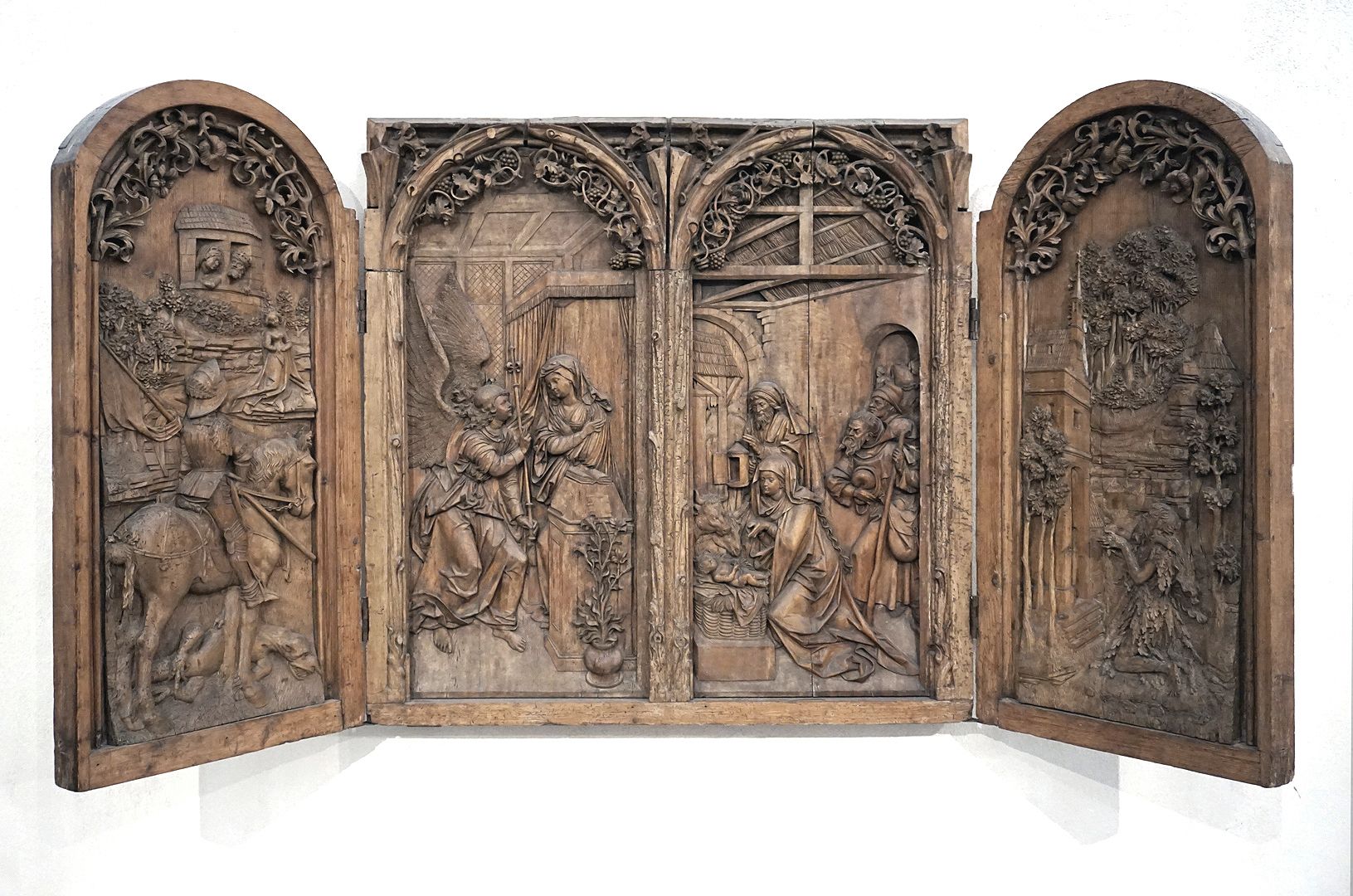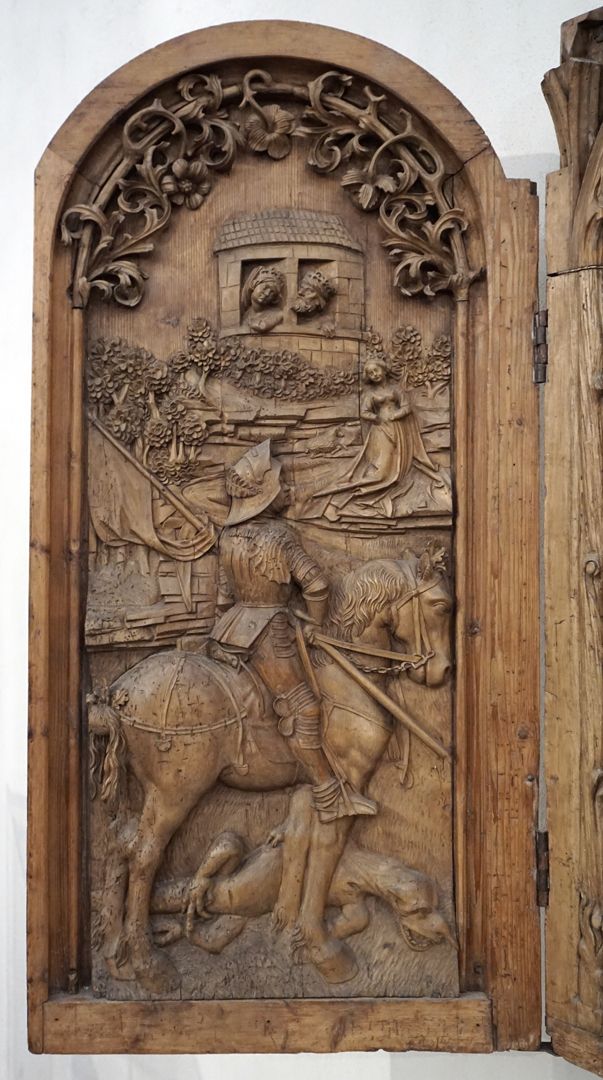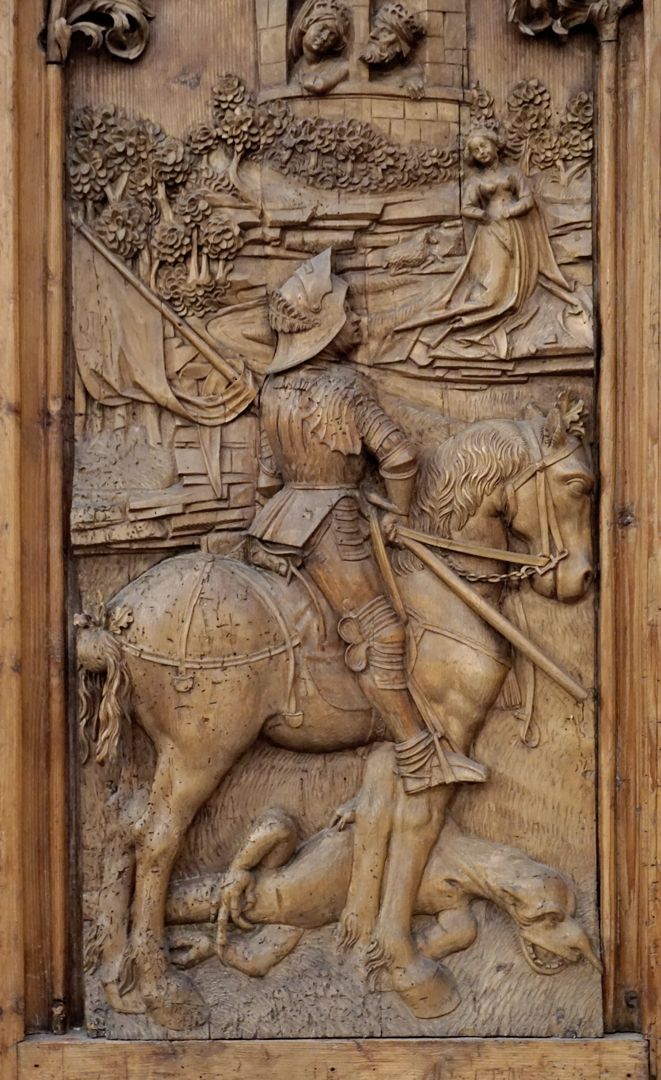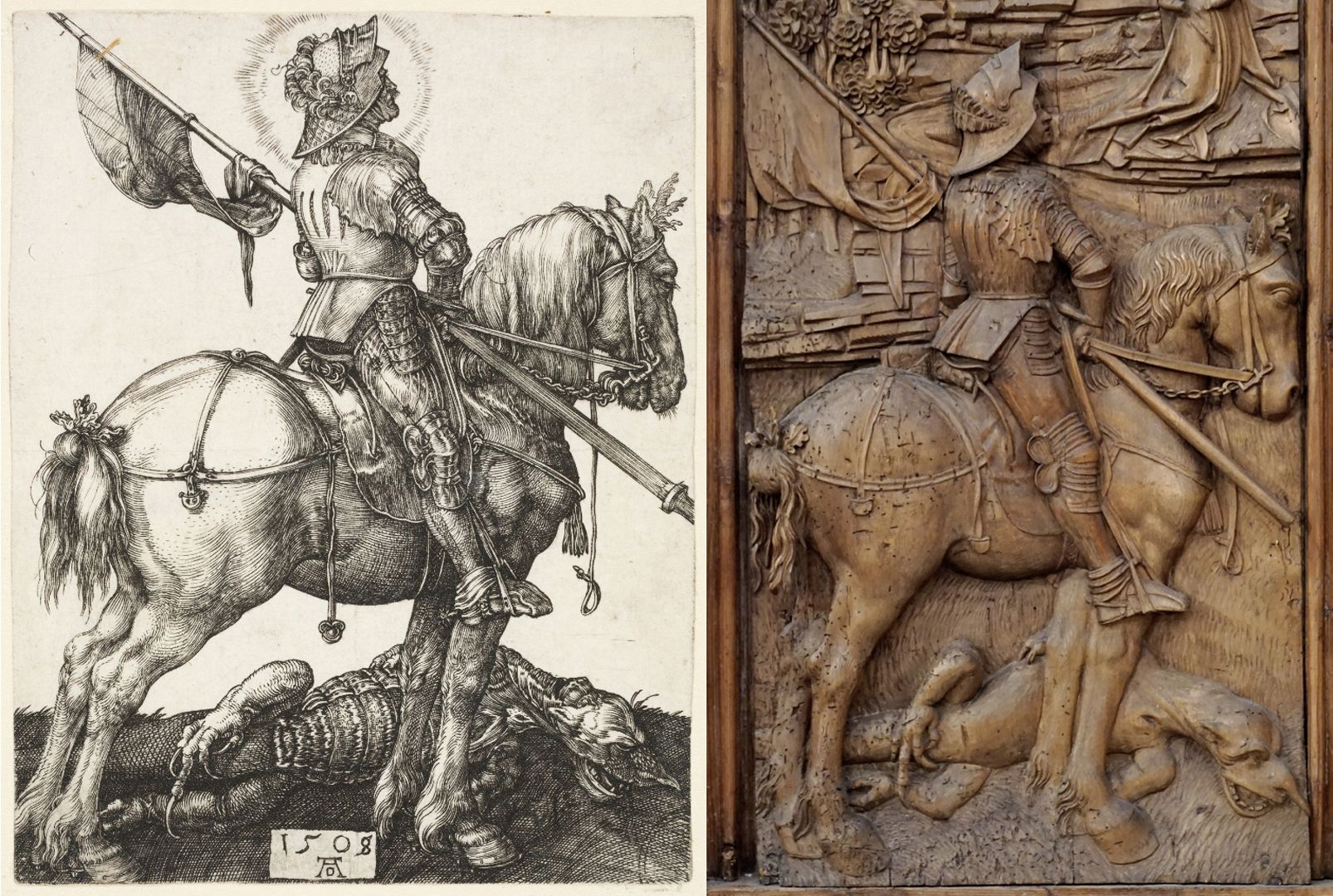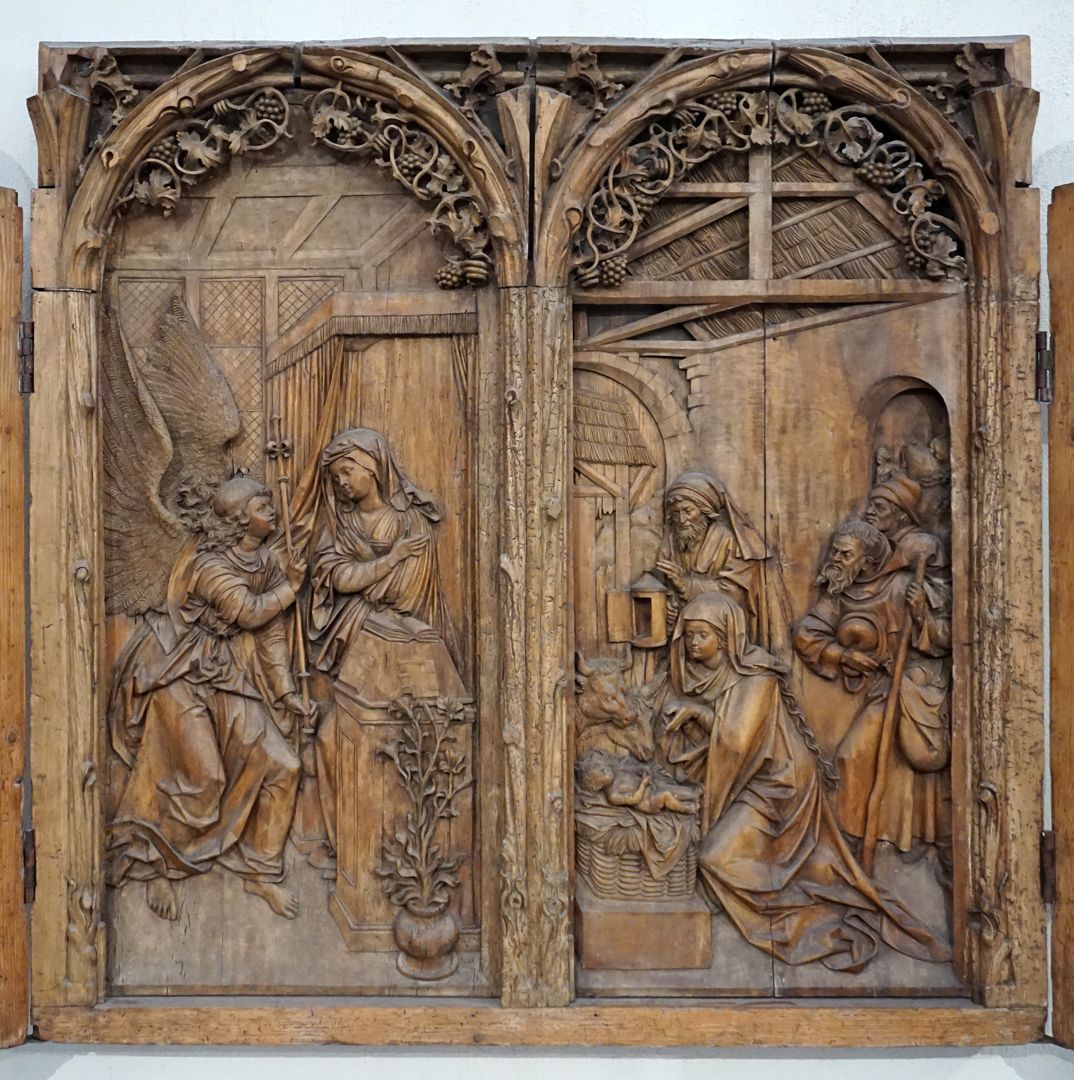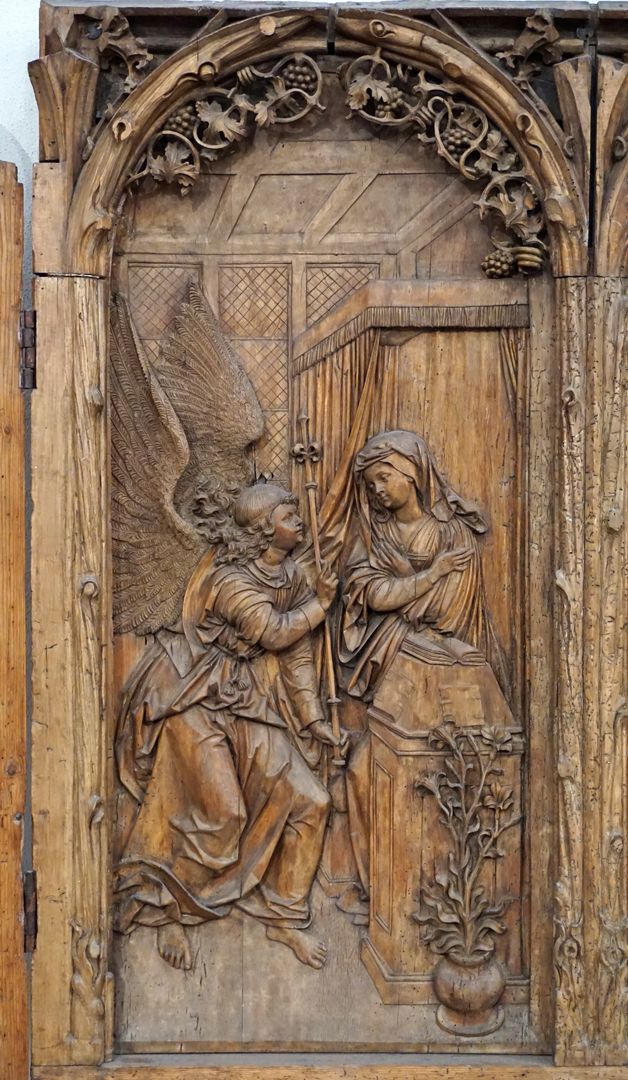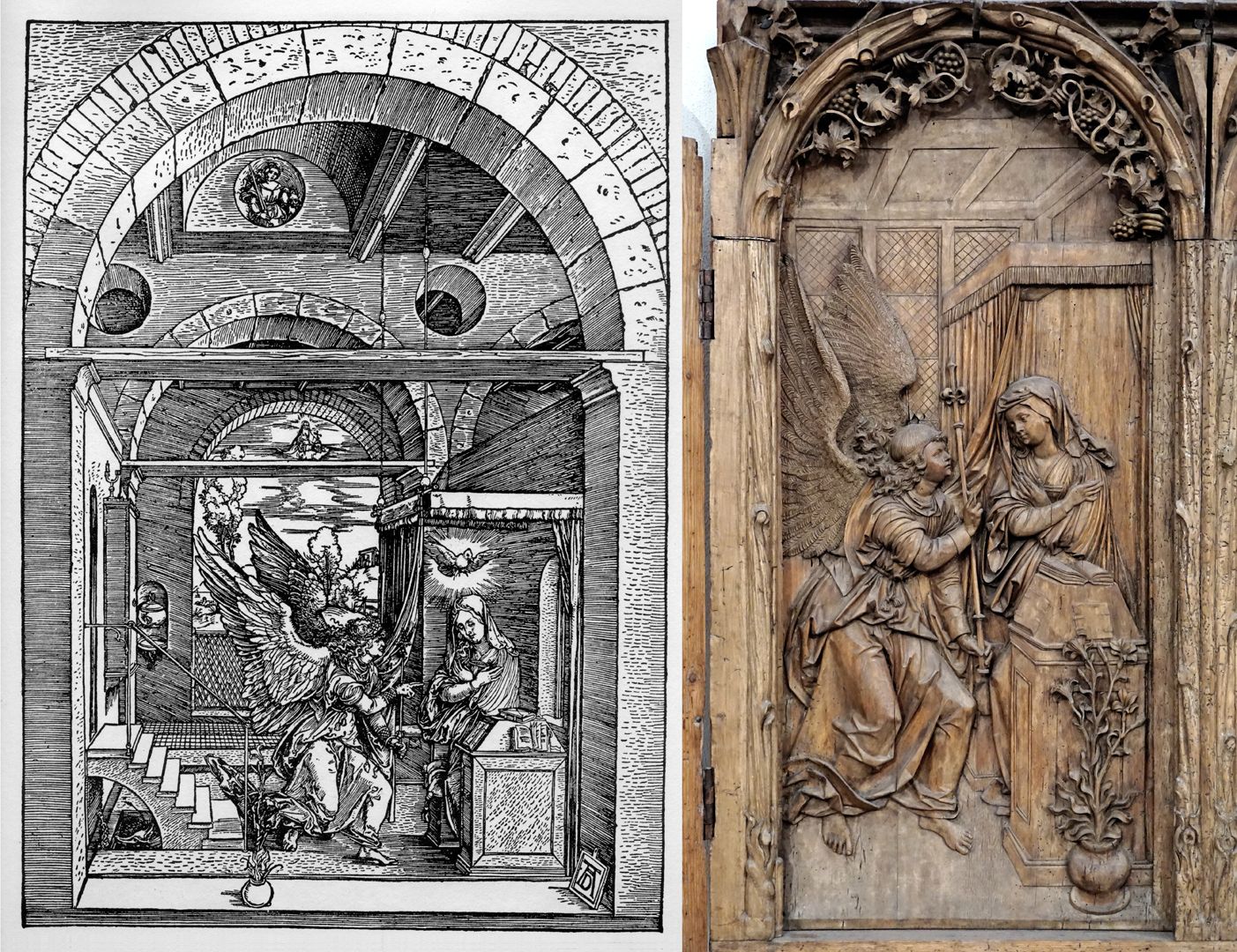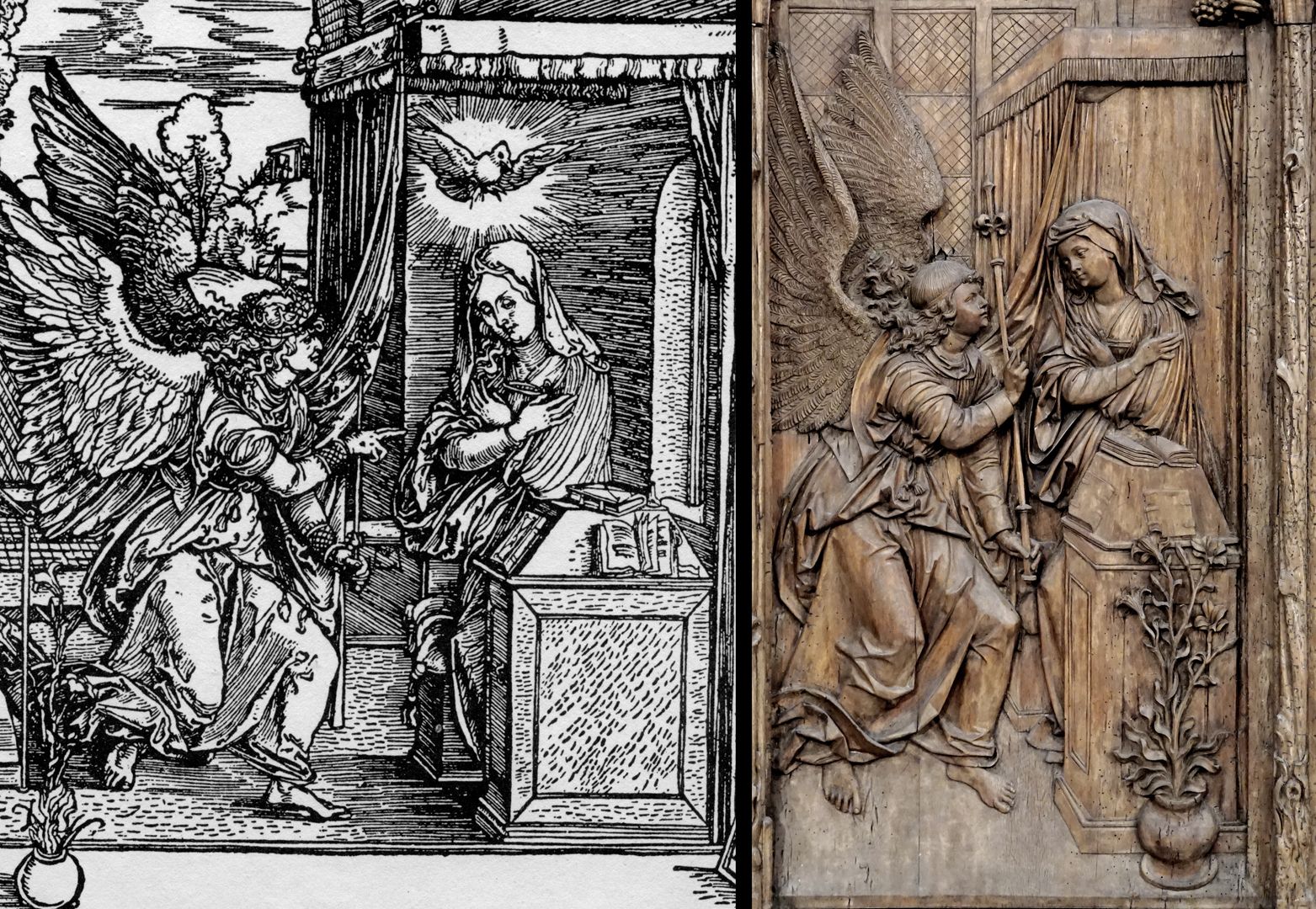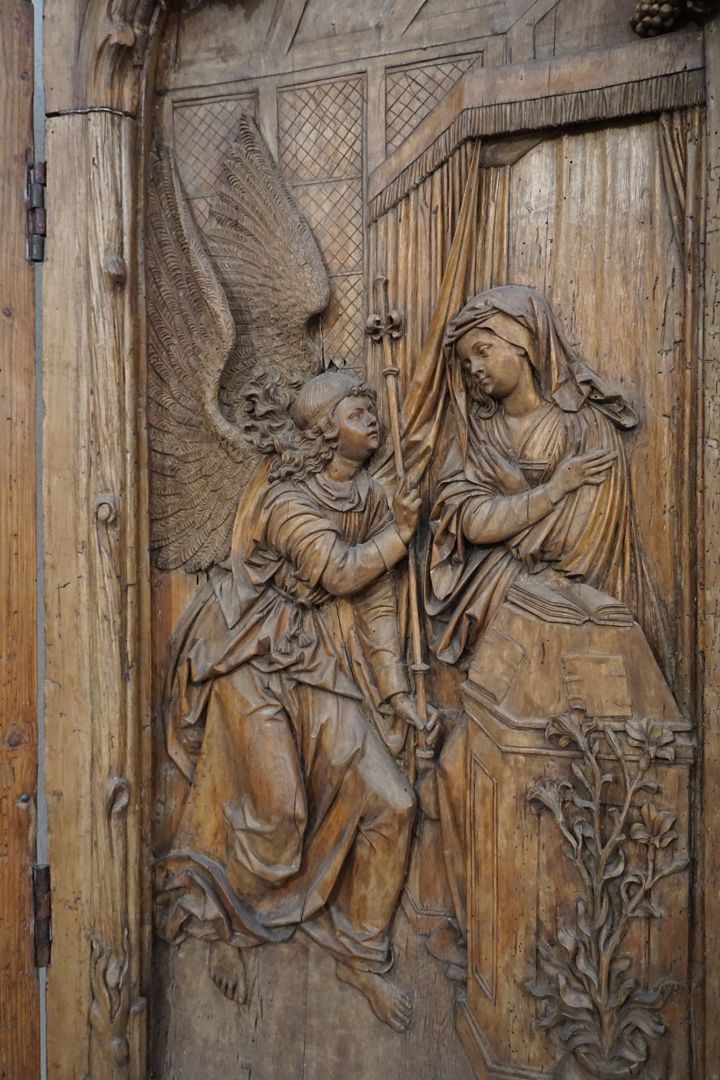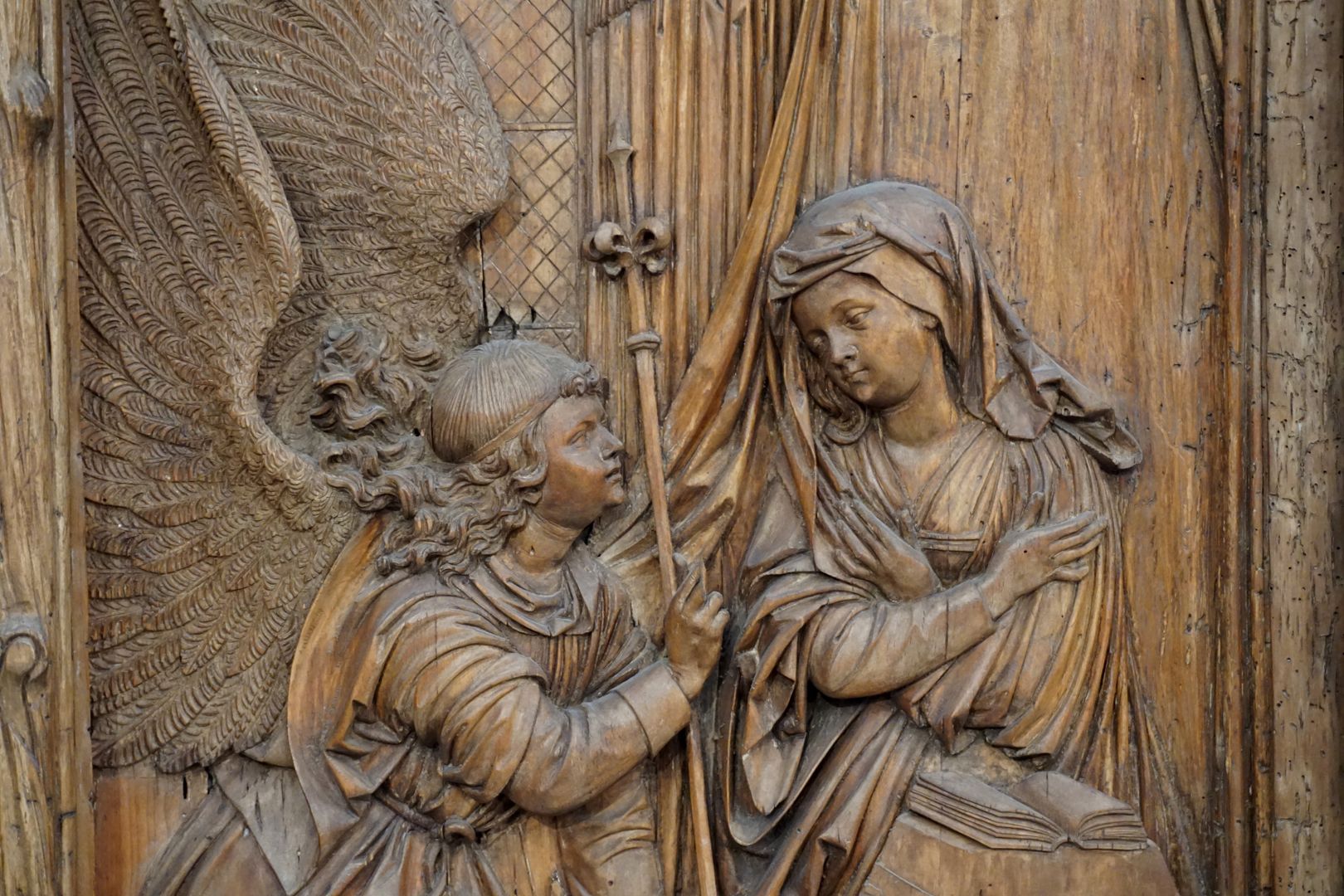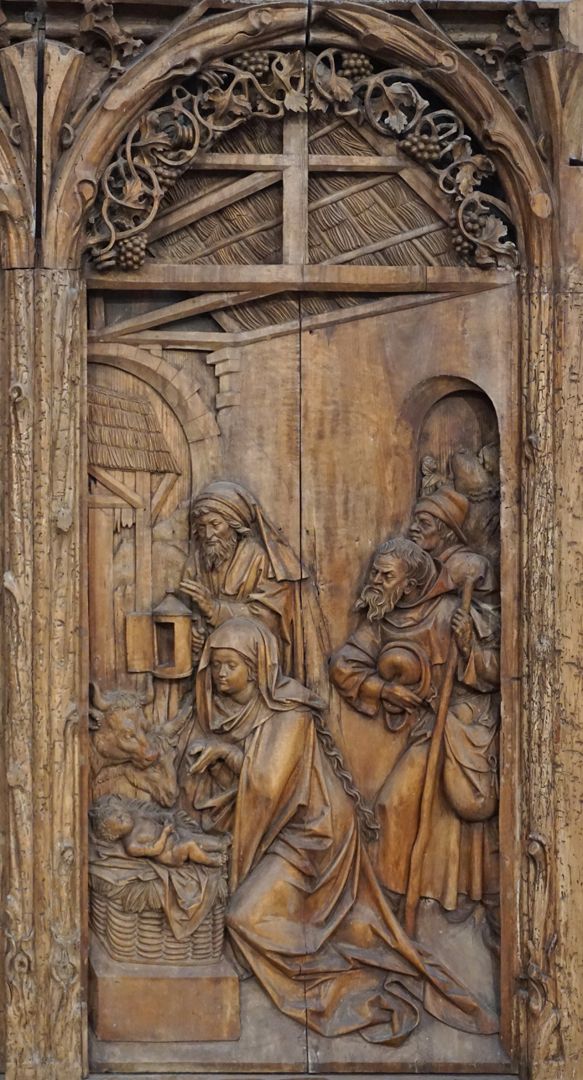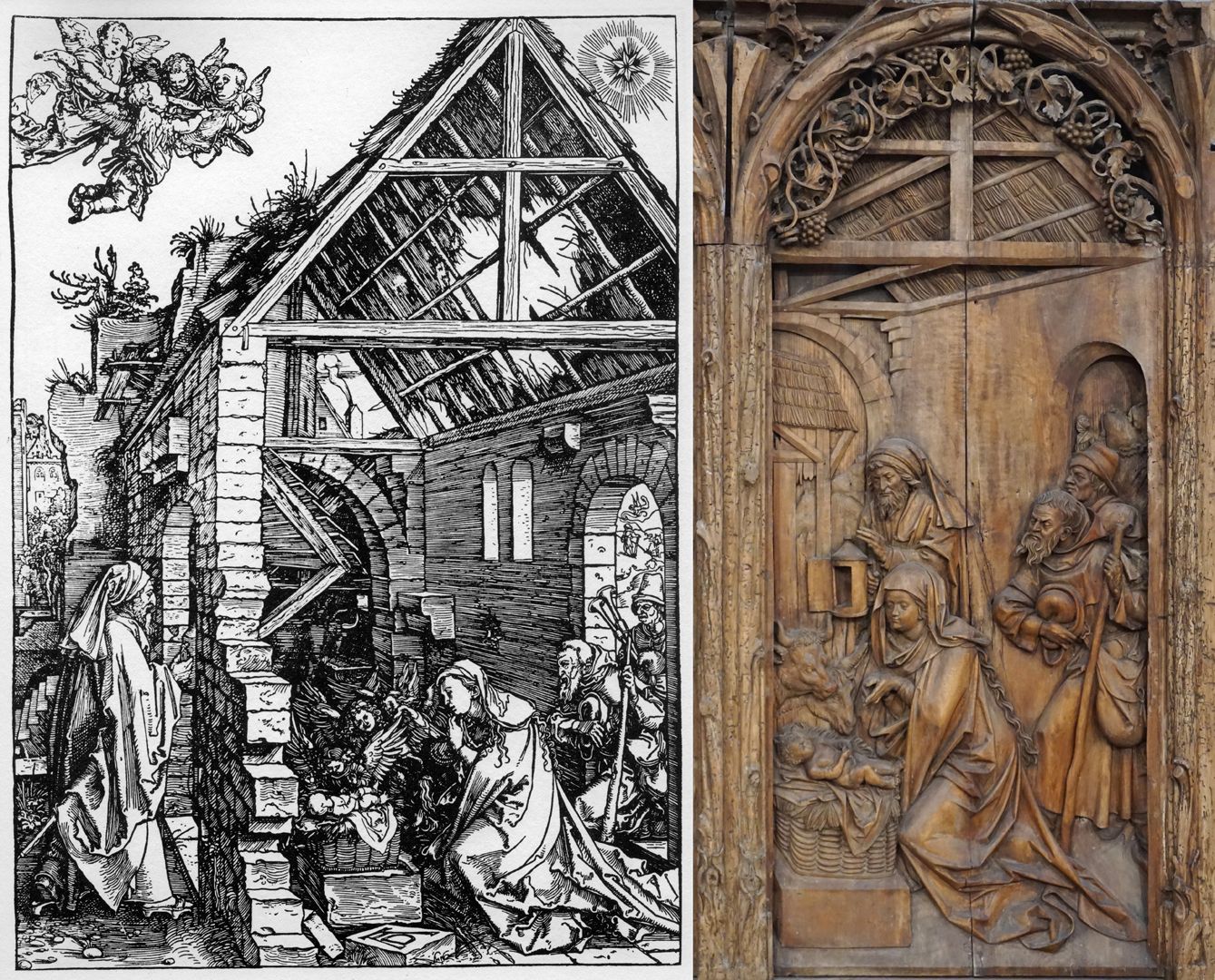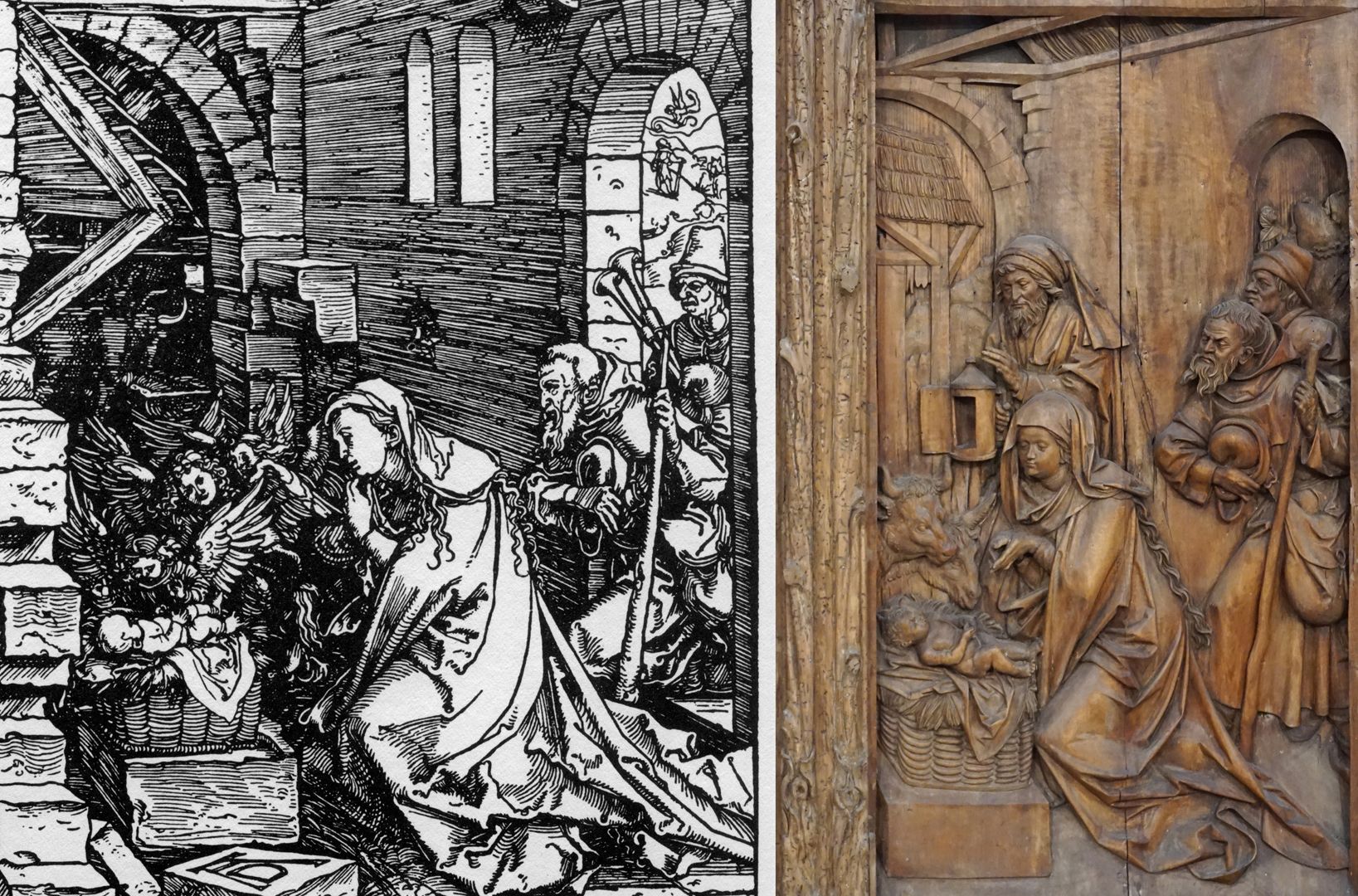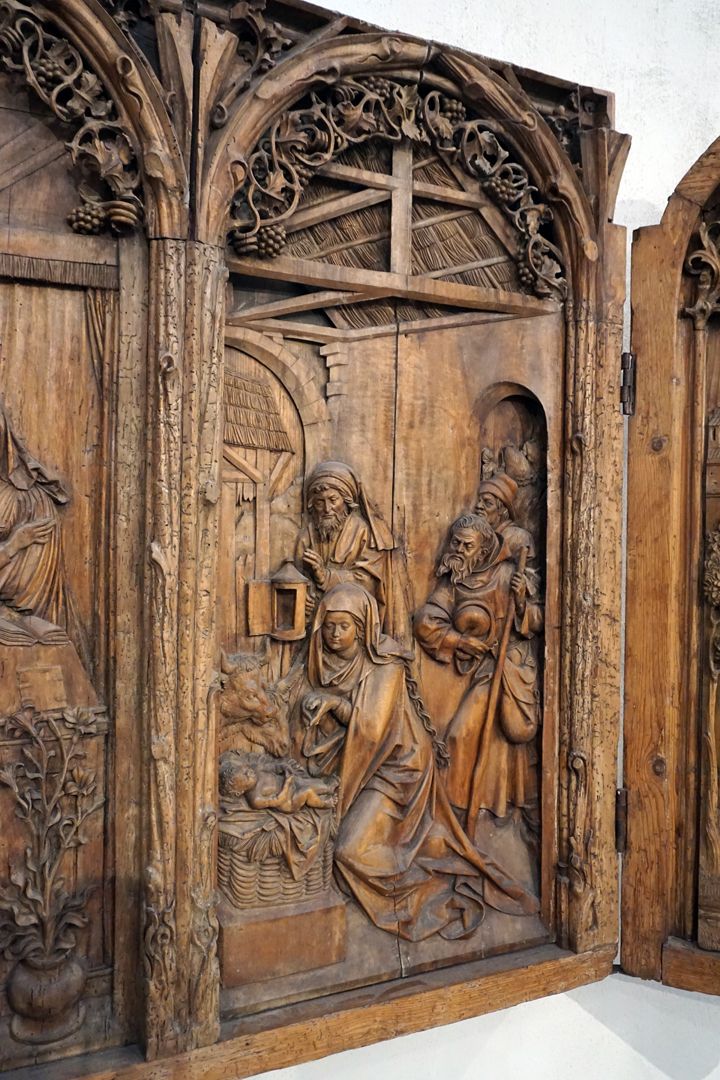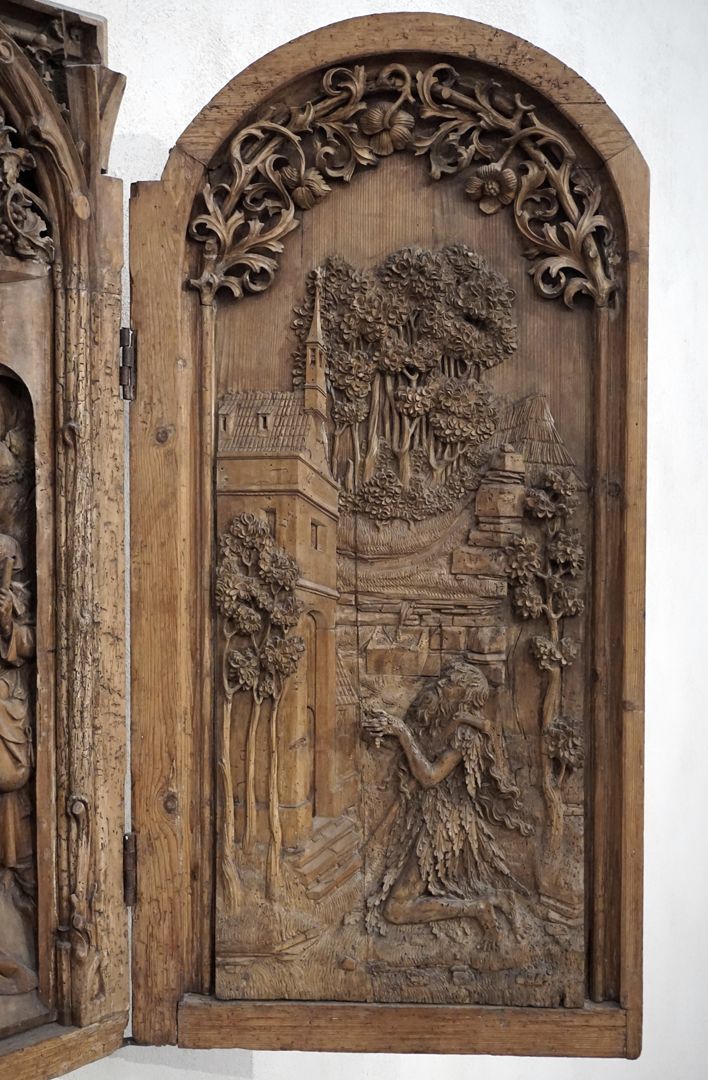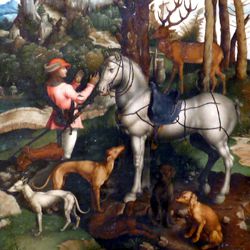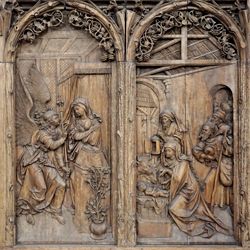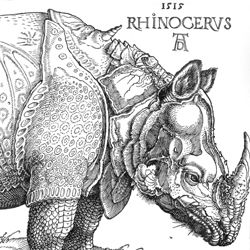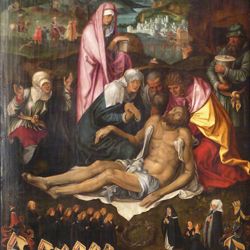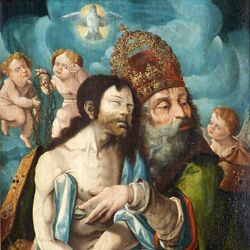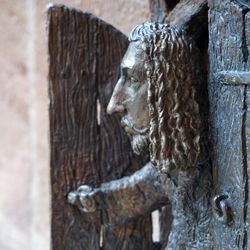Bergheim Altar
Bergheim Altar
1515 1517
Numerous engravings by Martin Schongauer and Albrecht Dürer provided the models for artists who transferred them to another visual medium. The Bergheim Altar is a typical example of the spread of print models. It is attributed to the carver Veit Wagner, who worked in the Strasbourg region between 1492 and 1510. For the church of Bergheim near Colmar he created an altar for which he was based heavily on Dürer engravings, namely St. George slaying the dragon, the Annunciation and the Adoration of the Shepherds. A certain harshness in the execution makes it clear how difficult it is to transfer the graphic original to a relief. The perspective spatial design achieved by staggering the levels is convincing. On the fourth panel Wagner depicted a praying hermit, possibly St. Onuphrius. (Musee Unterlinden, Colmar) The outside of the two wings, which were open to churchgoers when closed, are painted. Depicted are John the Baptist and John the Evangelist. Carver: Veit Wagner (1420 - c. 1517)
photo 11. Jan 2024, Theo Noll
Bergheim Altar
1515 1517
Left side panel: St. George and the dragon
Numerous engravings by Martin Schongauer and Albrecht Dürer provided the models for artists who transferred them to another visual medium. The Bergheim Altar is a typical example of the spread of print models. It is attributed to the carver Veit Wagner, who worked in the Strasbourg region between 1492 and 1510. For the church of Bergheim near Colmar he created an altar for which he was based heavily on Dürer engravings, namely St. George slaying the dragon, the Annunciation and the Adoration of the Shepherds. A certain harshness in the execution makes it clear how difficult it is to transfer the graphic original to a relief. The perspective spatial design achieved by staggering the levels is convincing. On the fourth panel Wagner depicted a praying hermit, possibly St. Onuphrius. (Musee Unterlinden, Colmar) The outside of the two wings, which were open to churchgoers when closed, are painted. Depicted are John the Baptist and John the Evangelist. Carver: Veit Wagner (1420 - c. 1517)
photo 11. Jan 2024, Theo Noll
Bergheim Altar
1515 1517
Left side panel: St. George and the dragon, detail
Numerous engravings by Martin Schongauer and Albrecht Dürer provided the models for artists who transferred them to another visual medium. The Bergheim Altar is a typical example of the spread of print models. It is attributed to the carver Veit Wagner, who worked in the Strasbourg region between 1492 and 1510. For the church of Bergheim near Colmar he created an altar for which he was based heavily on Dürer engravings, namely St. George slaying the dragon, the Annunciation and the Adoration of the Shepherds. A certain harshness in the execution makes it clear how difficult it is to transfer the graphic original to a relief. The perspective spatial design achieved by staggering the levels is convincing. On the fourth panel Wagner depicted a praying hermit, possibly St. Onuphrius. (Musee Unterlinden, Colmar) The outside of the two wings, which were open to churchgoers when closed, are painted. Depicted are John the Baptist and John the Evangelist. Carver: Veit Wagner (1420 - c. 1517)
photo 11. Jan 2024, Theo Noll
Bergheim Altar
1515 1517
Dürer template, copperplate engraving from 1508: St. George and dragon (Image source: Georg-August-Universität Göttingen / Art history seminar and art collection of the university / Inventory number D 894)
Numerous engravings by Martin Schongauer and Albrecht Dürer provided the models for artists who transferred them to another visual medium. The Bergheim Altar is a typical example of the spread of print models. It is attributed to the carver Veit Wagner, who worked in the Strasbourg region between 1492 and 1510. For the church of Bergheim near Colmar he created an altar for which he was based heavily on Dürer engravings, namely St. George slaying the dragon, the Annunciation and the Adoration of the Shepherds. A certain harshness in the execution makes it clear how difficult it is to transfer the graphic original to a relief. The perspective spatial design achieved by staggering the levels is convincing. On the fourth panel Wagner depicted a praying hermit, possibly St. Onuphrius. (Musee Unterlinden, Colmar) The outside of the two wings, which were open to churchgoers when closed, are painted. Depicted are John the Baptist and John the Evangelist. Carver: Veit Wagner (1420 - c. 1517)
photo 11. Jan 2024, Theo Noll
Bergheim Altar
1515 1517
Middle shrine: Annunciation / birth of Jesus with the arriving shepherds
Numerous engravings by Martin Schongauer and Albrecht Dürer provided the models for artists who transferred them to another visual medium. The Bergheim Altar is a typical example of the spread of print models. It is attributed to the carver Veit Wagner, who worked in the Strasbourg region between 1492 and 1510. For the church of Bergheim near Colmar he created an altar for which he was based heavily on Dürer engravings, namely St. George slaying the dragon, the Annunciation and the Adoration of the Shepherds. A certain harshness in the execution makes it clear how difficult it is to transfer the graphic original to a relief. The perspective spatial design achieved by staggering the levels is convincing. On the fourth panel Wagner depicted a praying hermit, possibly St. Onuphrius. (Musee Unterlinden, Colmar) The outside of the two wings, which were open to churchgoers when closed, are painted. Depicted are John the Baptist and John the Evangelist. Carver: Veit Wagner (1420 - c. 1517)
photo 11. Jan 2024, Theo Noll
Bergheim Altar
1515 1517
Annunciation
Numerous engravings by Martin Schongauer and Albrecht Dürer provided the models for artists who transferred them to another visual medium. The Bergheim Altar is a typical example of the spread of print models. It is attributed to the carver Veit Wagner, who worked in the Strasbourg region between 1492 and 1510. For the church of Bergheim near Colmar he created an altar for which he was based heavily on Dürer engravings, namely St. George slaying the dragon, the Annunciation and the Adoration of the Shepherds. A certain harshness in the execution makes it clear how difficult it is to transfer the graphic original to a relief. The perspective spatial design achieved by staggering the levels is convincing. On the fourth panel Wagner depicted a praying hermit, possibly St. Onuphrius. (Musee Unterlinden, Colmar) The outside of the two wings, which were open to churchgoers when closed, are painted. Depicted are John the Baptist and John the Evangelist. Carver: Veit Wagner (1420 - c. 1517)
photo 11. Jan 2024, Theo Noll
Bergheim Altar
1515 1517
Dürer template: The Life of Mary (1502-1510), Annunciation (woodcut)
Numerous engravings by Martin Schongauer and Albrecht Dürer provided the models for artists who transferred them to another visual medium. The Bergheim Altar is a typical example of the spread of print models. It is attributed to the carver Veit Wagner, who worked in the Strasbourg region between 1492 and 1510. For the church of Bergheim near Colmar he created an altar for which he was based heavily on Dürer engravings, namely St. George slaying the dragon, the Annunciation and the Adoration of the Shepherds. A certain harshness in the execution makes it clear how difficult it is to transfer the graphic original to a relief. The perspective spatial design achieved by staggering the levels is convincing. On the fourth panel Wagner depicted a praying hermit, possibly St. Onuphrius. (Musee Unterlinden, Colmar) The outside of the two wings, which were open to churchgoers when closed, are painted. Depicted are John the Baptist and John the Evangelist. Carver: Veit Wagner (1420 - c. 1517)
photo 2024, Theo Noll
Bergheim Altar
1515 1517
Dürer template: The Life of Mary (1502-1510), Annunciation (woodcut)
Numerous engravings by Martin Schongauer and Albrecht Dürer provided the models for artists who transferred them to another visual medium. The Bergheim Altar is a typical example of the spread of print models. It is attributed to the carver Veit Wagner, who worked in the Strasbourg region between 1492 and 1510. For the church of Bergheim near Colmar he created an altar for which he was based heavily on Dürer engravings, namely St. George slaying the dragon, the Annunciation and the Adoration of the Shepherds. A certain harshness in the execution makes it clear how difficult it is to transfer the graphic original to a relief. The perspective spatial design achieved by staggering the levels is convincing. On the fourth panel Wagner depicted a praying hermit, possibly St. Onuphrius. (Musee Unterlinden, Colmar) The outside of the two wings, which were open to churchgoers when closed, are painted. Depicted are John the Baptist and John the Evangelist. Carver: Veit Wagner (1420 - c. 1517)
photo 2024, Theo Noll
Bergheim Altar
1515 1517
Annunciation, oblique view
Numerous engravings by Martin Schongauer and Albrecht Dürer provided the models for artists who transferred them to another visual medium. The Bergheim Altar is a typical example of the spread of print models. It is attributed to the carver Veit Wagner, who worked in the Strasbourg region between 1492 and 1510. For the church of Bergheim near Colmar he created an altar for which he was based heavily on Dürer engravings, namely St. George slaying the dragon, the Annunciation and the Adoration of the Shepherds. A certain harshness in the execution makes it clear how difficult it is to transfer the graphic original to a relief. The perspective spatial design achieved by staggering the levels is convincing. On the fourth panel Wagner depicted a praying hermit, possibly St. Onuphrius. (Musee Unterlinden, Colmar) The outside of the two wings, which were open to churchgoers when closed, are painted. Depicted are John the Baptist and John the Evangelist. Carver: Veit Wagner (1420 - c. 1517)
photo 11. Jan 2024, Theo Noll
Bergheim Altar
1515 1517
Annunciation, detailed view
Numerous engravings by Martin Schongauer and Albrecht Dürer provided the models for artists who transferred them to another visual medium. The Bergheim Altar is a typical example of the spread of print models. It is attributed to the carver Veit Wagner, who worked in the Strasbourg region between 1492 and 1510. For the church of Bergheim near Colmar he created an altar for which he was based heavily on Dürer engravings, namely St. George slaying the dragon, the Annunciation and the Adoration of the Shepherds. A certain harshness in the execution makes it clear how difficult it is to transfer the graphic original to a relief. The perspective spatial design achieved by staggering the levels is convincing. On the fourth panel Wagner depicted a praying hermit, possibly St. Onuphrius. (Musee Unterlinden, Colmar) The outside of the two wings, which were open to churchgoers when closed, are painted. Depicted are John the Baptist and John the Evangelist. Carver: Veit Wagner (1420 - c. 1517)
photo 11. Jan 2024, Theo Noll
Bergheim Altar
1515 1517
Birth of Jesus with the arriving shephards
Numerous engravings by Martin Schongauer and Albrecht Dürer provided the models for artists who transferred them to another visual medium. The Bergheim Altar is a typical example of the spread of print models. It is attributed to the carver Veit Wagner, who worked in the Strasbourg region between 1492 and 1510. For the church of Bergheim near Colmar he created an altar for which he was based heavily on Dürer engravings, namely St. George slaying the dragon, the Annunciation and the Adoration of the Shepherds. A certain harshness in the execution makes it clear how difficult it is to transfer the graphic original to a relief. The perspective spatial design achieved by staggering the levels is convincing. On the fourth panel Wagner depicted a praying hermit, possibly St. Onuphrius. (Musee Unterlinden, Colmar) The outside of the two wings, which were open to churchgoers when closed, are painted. Depicted are John the Baptist and John the Evangelist. Carver: Veit Wagner (1420 - c. 1517)
photo 11. Jan 2024, Theo Noll
Bergheim Altar
1515 1517
Dürer template: The life of Mary (1502-1510), Jesus' birth and adoration (woodcut)
Numerous engravings by Martin Schongauer and Albrecht Dürer provided the models for artists who transferred them to another visual medium. The Bergheim Altar is a typical example of the spread of print models. It is attributed to the carver Veit Wagner, who worked in the Strasbourg region between 1492 and 1510. For the church of Bergheim near Colmar he created an altar for which he was based heavily on Dürer engravings, namely St. George slaying the dragon, the Annunciation and the Adoration of the Shepherds. A certain harshness in the execution makes it clear how difficult it is to transfer the graphic original to a relief. The perspective spatial design achieved by staggering the levels is convincing. On the fourth panel Wagner depicted a praying hermit, possibly St. Onuphrius. (Musee Unterlinden, Colmar) The outside of the two wings, which were open to churchgoers when closed, are painted. Depicted are John the Baptist and John the Evangelist. Carver: Veit Wagner (1420 - c. 1517)
photo 11. Jan 2024, Theo Noll
Bergheim Altar
1515 1517
Dürer template: The life of Mary (1502-1510), Jesus' birth and adoration (woodcut)
Numerous engravings by Martin Schongauer and Albrecht Dürer provided the models for artists who transferred them to another visual medium. The Bergheim Altar is a typical example of the spread of print models. It is attributed to the carver Veit Wagner, who worked in the Strasbourg region between 1492 and 1510. For the church of Bergheim near Colmar he created an altar for which he was based heavily on Dürer engravings, namely St. George slaying the dragon, the Annunciation and the Adoration of the Shepherds. A certain harshness in the execution makes it clear how difficult it is to transfer the graphic original to a relief. The perspective spatial design achieved by staggering the levels is convincing. On the fourth panel Wagner depicted a praying hermit, possibly St. Onuphrius. (Musee Unterlinden, Colmar) The outside of the two wings, which were open to churchgoers when closed, are painted. Depicted are John the Baptist and John the Evangelist. Carver: Veit Wagner (1420 - c. 1517)
photo 11. Jan 2024, Theo Noll
Bergheim Altar
1515 1517
Birth of Jesus with Adoration of the Magi, oblique view
Numerous engravings by Martin Schongauer and Albrecht Dürer provided the models for artists who transferred them to another visual medium. The Bergheim Altar is a typical example of the spread of print models. It is attributed to the carver Veit Wagner, who worked in the Strasbourg region between 1492 and 1510. For the church of Bergheim near Colmar he created an altar for which he was based heavily on Dürer engravings, namely St. George slaying the dragon, the Annunciation and the Adoration of the Shepherds. A certain harshness in the execution makes it clear how difficult it is to transfer the graphic original to a relief. The perspective spatial design achieved by staggering the levels is convincing. On the fourth panel Wagner depicted a praying hermit, possibly St. Onuphrius. (Musee Unterlinden, Colmar) The outside of the two wings, which were open to churchgoers when closed, are painted. Depicted are John the Baptist and John the Evangelist. Carver: Veit Wagner (1420 - c. 1517)
photo 11. Jan 2024, Theo Noll
Bergheim Altar
1515 1517
right side panel: hermit in leafy dress, St. Onuphrius (?)
Numerous engravings by Martin Schongauer and Albrecht Dürer provided the models for artists who transferred them to another visual medium. The Bergheim Altar is a typical example of the spread of print models. It is attributed to the carver Veit Wagner, who worked in the Strasbourg region between 1492 and 1510. For the church of Bergheim near Colmar he created an altar for which he was based heavily on Dürer engravings, namely St. George slaying the dragon, the Annunciation and the Adoration of the Shepherds. A certain harshness in the execution makes it clear how difficult it is to transfer the graphic original to a relief. The perspective spatial design achieved by staggering the levels is convincing. On the fourth panel Wagner depicted a praying hermit, possibly St. Onuphrius. (Musee Unterlinden, Colmar) The outside of the two wings, which were open to churchgoers when closed, are painted. Depicted are John the Baptist and John the Evangelist. Carver: Veit Wagner (1420 - c. 1517)
photo 11. Jan 2024, Theo Noll
Bergheim Altar
1515 1517
Right side panel: hermit in a dress of leaves, St. Onuphrius (?), detailed view
Numerous engravings by Martin Schongauer and Albrecht Dürer provided the models for artists who transferred them to another visual medium. The Bergheim Altar is a typical example of the spread of print models. It is attributed to the carver Veit Wagner, who worked in the Strasbourg region between 1492 and 1510. For the church of Bergheim near Colmar he created an altar for which he was based heavily on Dürer engravings, namely St. George slaying the dragon, the Annunciation and the Adoration of the Shepherds. A certain harshness in the execution makes it clear how difficult it is to transfer the graphic original to a relief. The perspective spatial design achieved by staggering the levels is convincing. On the fourth panel Wagner depicted a praying hermit, possibly St. Onuphrius. (Musee Unterlinden, Colmar) The outside of the two wings, which were open to churchgoers when closed, are painted. Depicted are John the Baptist and John the Evangelist. Carver: Veit Wagner (1420 - c. 1517)
photo 11. Jan 2024, Theo Noll
Bergheim Altar
1515 1517
Right side panel: hermit in a dress of leaves, St. Onuphrius (?), detailed view
Numerous engravings by Martin Schongauer and Albrecht Dürer provided the models for artists who transferred them to another visual medium. The Bergheim Altar is a typical example of the spread of print models. It is attributed to the carver Veit Wagner, who worked in the Strasbourg region between 1492 and 1510. For the church of Bergheim near Colmar he created an altar for which he was based heavily on Dürer engravings, namely St. George slaying the dragon, the Annunciation and the Adoration of the Shepherds. A certain harshness in the execution makes it clear how difficult it is to transfer the graphic original to a relief. The perspective spatial design achieved by staggering the levels is convincing. On the fourth panel Wagner depicted a praying hermit, possibly St. Onuphrius. (Musee Unterlinden, Colmar) The outside of the two wings, which were open to churchgoers when closed, are painted. Depicted are John the Baptist and John the Evangelist. Carver: Veit Wagner (1420 - c. 1517)
photo 11. Jan 2024, Theo Noll
